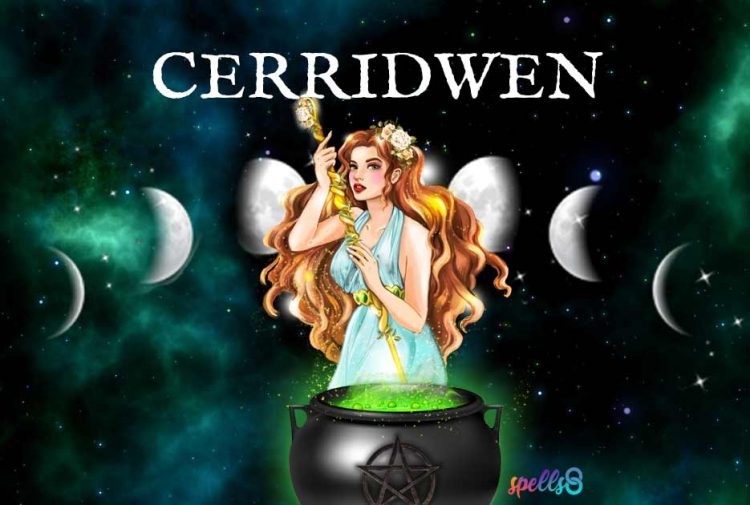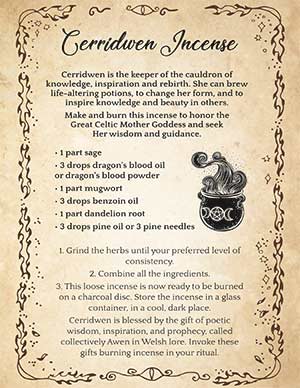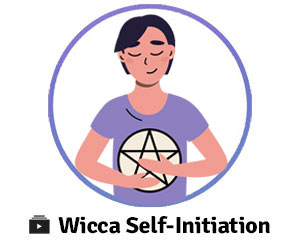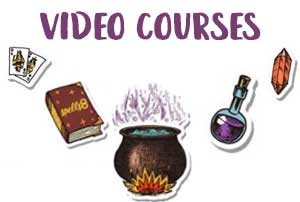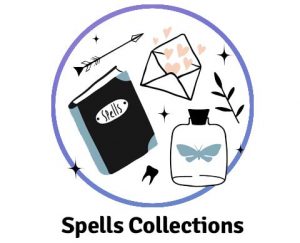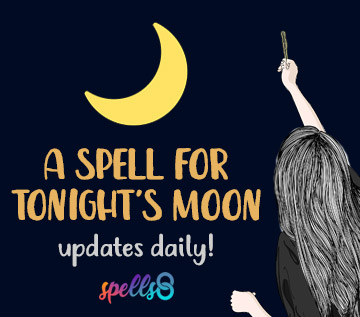Cerridwen (sometimes known as Ceridwen or Caridwen) is a goddess of Welsh legend. Sometimes she is depicted as an enchantress, but she always possesses some degree of magical power. Much of what is known about this particular incarnation of Cerridwen comes from the Hanes Taliesin (The Tale of Taliesin), an account of the legendary poet Taliesin. She is famous for her magical cauldron, as well as her hideous son, Morfran, and her beautiful daughter Creirwy.
Working with Cerridwen
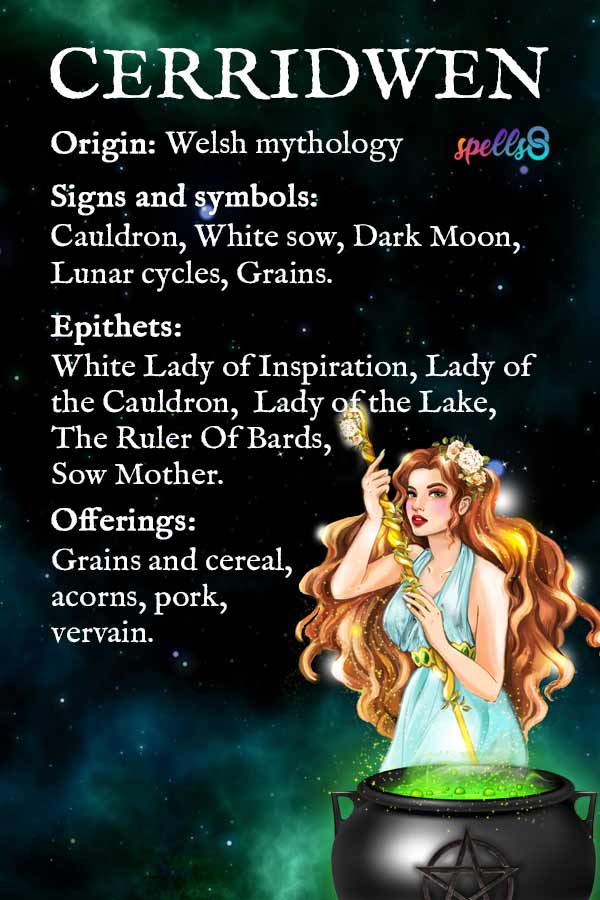
The best way to connect with Cerridwen, like any goddess or god, is through the mythology, epithets and symbols. Here’s a summary of the most important tales featuring the goddess Cerridwen, and how to worship Her in your personal pagan practice.
- Myth of Cerridwen
- Symbols of Cerridwen
- Titles and Epithets of Cerridwen
- How to Worship Cerridwen as a Goddess
- Further reading
Myth of Cerridwen
Cerridwen and her husband, Tegid Voel, lived at Lake Tegid. She gave birth to her fantastically ugly son, Morfran, and the most fair of all maidens, Creirwy. Unfortunately for Morfran, Cerridwen thought the lad was so hideous that it would be impossible for him to gain admittance among the ranks of the noble-born. Still, Cerridwen’s love for her son led her to hatch a plot for his acceptance. The boy may be ugly, but nobody said he had to be stupid. Cerridwen decided to go to her magical cauldron for a solution, which contained all manner of poetic and scientific inspiration.
“The boy be harsh on the eyes,” Cerridwen muttered. “But he shall not be soft in the head.”
She set the cauldron to boiling, and boil it must for at least a year and a day. Cerridwen needed only three drops from the cauldron, three drops of inspiration.
To keep the cauldron boiling for a year, she enlisted the aid of Gwion Bach and the blind man, Morda. She charged Gwion Bach with the constant stirring of the cauldron and likewise charged Morda with kindling the fire continuously.
“Keep it boiling for a year and a day,” she said. “I must gather herbs.”
As Gwion Bach and Morda toiled, Cerridwen gathered every type of charm-bearing herb that she could find. One day, while Cerridwen was diligently gathering the herbs, three drops of inspiration flew from the cauldron. They landed on Gwion Bach’s finger. He yelped in pain at the heat of the drops, and placed his finger in his mouth to cool it off.
As the drops entered his system, Time itself cracked open and revealed secrets to Gwion Bach. It became apparent to Gwion Bach that this accident would invoke Cerridwen’s wrath, and that he must protect himself against her many skills.
Fearing for his life, Gwion Bach fled in the direction of his homeland. The cauldron he and Morda had been tending split into pieces. The liquid that poured forth from the cauldron flowed in a river of poison that killed many horses in its wake. By a twist of fate, only the three small drops that Gwion Bach had licked off his finger were non-toxic.
Cerridwen noticed the tide of poison flowing from the ruins of her cauldron. Consumed by rage, she grabbed a chunk of wood and clouted Morda over the head with it, dashing him so hard that one of his eyes popped out and dangled on his cheek.
“Please, please!” Morda shrieked. “You do the wrong one evil, Mistress Cerridwen! It was not I that drank of your cauldron and ruined a year and a day’s worth of toil!”
Cerridwen let the chunk of wood slip from her grasp, knowing what Morda spoke was true.
“Gwion Bach,” she said. “He is the rogue that stole my potion of inspiration.”
She hotly pursued after Gwion Bach. Gwion Bach realized this and, thinking himself clever, turned himself into a hare. He darted to and fro, but Cerridwen transformed herself into a greyhound and redoubled her pursuit. He made towards a river and shed his hare form, adopting the form of a fish. Cerridwen did not hesitate as she dove in the river after him, turning into an otter and paddled furiously in pursuit. As she bore down upon him, Gwion Bach leapt from the stream and took flight as a bird. Not one to be outdone, Cerridwen likewise left the stream in the form of a hawk. She harried him again and again, never affording him a moment’s respite. Then, Gwion Bach noticed a barn full of winnowed wheat.
“I’ll lose my pursuer here,” he thought to himself, and dove in. He transformed himself into one grain of wheat among many.
As the story goes, Cerridwen turned herself into a high-crested hen. She began picking through the grains one by one by one, scratching at the grains with her feet until she found the grain that Gwion Bach had disguised himself as. With a gulp, she swallowed Gwion Bach right up.
Satisfied, she left the barn, bearing Gwion Bach in her belly. For nine months she carried Gwion Bach in her, and when she finally gave birth to him, she gently held the babe in her arms.
He was a most beautiful baby. Cerridwen realized that, despite her earlier anger, she could not bring herself to kill such a beautiful child.
On the 29th of April, she wandered down to the sea, carrying a leather lantern bag in one hand and the baby Gwion Bach in the other. She wrapped the child in the bag and cast him into the sea.
“May God’s mercy protect ye,” she said, and left the baby Gwion Bach to his fate.
Gwion Bach would go on, like many abandoned children, to become a legendary figure in his own right. He lost his old name and became known as Taliesin. Cerridwen vanished into the mist of mystery here: wrathful enchantress turned to sorrowful mother. Taliesin sang many songs, some of them involving his misadventures with his mother and rival Cerridwen. He became known as “the greatest of all bards”.
Analysis of the Myth
Cerridwen is an intriguing figure from Welsh mythology. She begins her tale attempting to help her son Morfran, who has little chance of gaining acceptance with the nobility. Her instinct as a mother is to tend to her child, and this is troubled by the entrance of Gwion Bach into her life. While Gwion Bach does not harbor any malicious intent against Cerridwen, his inadvertent drinking of the three drops of inspiration nevertheless brings her wrath down upon him. Gwion Bach’s ‘theft’ in some sense resembles that of Prometheus or other divine thieves, except in this case he claims the prize for himself.
The most famous instance of Cerridwen’s tale involves the shapeshifting chase between her and Gwion Bach. There is a cyclical quality to their pursuit, with Gwion Bach changing into various prey animals (or food, in the case of the grains), and Cerridwen changing into various predators. Animals have been fleeing and hunting one another for as long as they have been around, and there’s a sense of the brutality of nature playing out during their chase. This culminates in Cerridwen eating Gwion Bach in the form of a grain. This is both a symbolic and literal death for Gwion Bach, as he loses his former life and gains a new one in the form of a baby.
Cerridwen, in the tale, becomes herself the cauldron of death-and-rebirth, a common theme across all manner of legends and mythology. Her body becomes the abyss where all seems lost, and yet it is also the potential for life renewed. She transforms Gwion Bach and is herself transformed as she can no longer bring herself to kill him.
Cerridwen’s spirit marks a boundary space between one adventure and the next. The climatic pursuit ends, but Gwion Bach’s death in this case is merely an illusion or staging area, as when he is reborn, Cerridwen wraps him in the lantern pouch and sends him off to sea with a blessing. Countless tales, from Moses to Perseus, feature a similar ‘exposure’ to the elements. The exposure frequently marks the origins of a mythological hero, but in order for the motif to work, it requires a figure such as Cerridwen to commit the exposure.
In this sense, Cerridwen can be seen as the entity that puts us out to sea. She changes us and renews us in unforeseen ways. We may be somewhat like infants, unable to resist the adventure she thrusts upon us, but it is up to us to take the goddess’s inspiration, as well as the new life she can grant, and make our way through the world with what is given.
Despite Cerridwen’s initial hostility at the beginning of the Tale of Taliesin, it is always interesting to note where a character develops and ends up. She starts out as pursuer, hunter, and the last we see of Cerridwen, she is nurturing and blessing. She cannot take care of the baby Gwion Bach, for some reason or another, but she gives him a blessing as he is set out into the wilderness, something she would surely would not have done towards the beginning of the story. In this sense, Cerridwen might also represent a change of fortune, or perhaps a change in perspective on a circumstance that may seem undesirable at first, but in fact lays the groundwork for new possibilities.
Symbols of Cerridwen
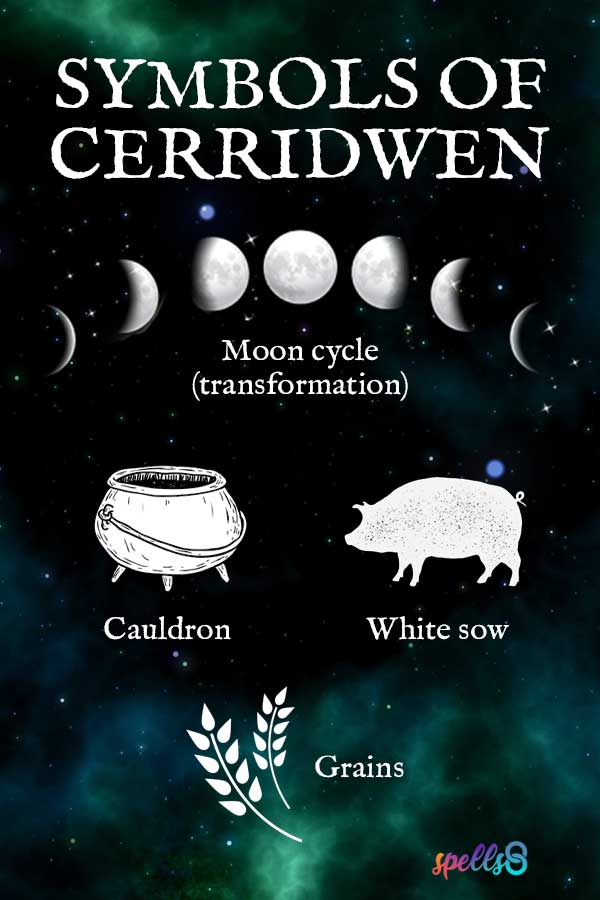
Cauldron: A symbol closely associated with the Divine Feminine, it is a vessel for transformation which symbolizes rebirth and renewal. Cerridwen’s cauldron represents the womb of the Great Mother Goddess, from which all life is born, and then born again. It’s also a cauldron of wisdom, knowledge and inspiration.
Dark Moon: In modern worship, Cerridwen is sometimes called “Dark Goddess of Transformation” and associated with the dark moon. Her connection with the dark side of Magic and Witchcraft has to do with her role in the poem of Taliesin, where She is not a goddess but rather a sorceress or witch with destructive powers. Also, Cerid- can be translated as “bent” or “crooked”, but it could also mean “poetry” or “song.”
Moon: The moon undergoes different phases and expressions, similar to the Goddess’s shapeshifting and transformation abilities. As a Moon Goddess, Cerridwen may be represented by the lunar cycle (New Moon to Full Moon and back) as a symbol of eternal transformation and renewal.
White sow: Among the Celts, Cerridwen was also known as the sow goddess. The pig was associated with the moon and with fertility and perceived as a gift from the otherworld. Some people believe her name means “White Sow” (although the exact meaning of the name is unknown).
Grain: In Cerridwen’s myth, Gwion shapeshifts into a grain of wheat. As a Goddess of fertility and harvest, different types of grain are associated to Her.
Titles and Epithets of Cerridwen
- White Lady of Inspiration
- Lady of the Cauldron
- Lady of the Lake
- The Ruler Of Bards
- Sow Mother
How to Worship Cerridwen as a Goddess
As Keeper of the Cauldron, Cerridwen brings inspiration, wisdom and the gifts of prophecy to those that work with Her. The best way to work with Cerridwen or other Celtic goddesses is to read the poems and tales that showcase her skills and abilities.
Cerridwen’s areas of influence are Magic, fertility, wisdom, poetry, creativity, herbalism, and the harvest. There are modern Pagans who consider Her the Queen of Witches. She pursues her prey with unfailing energy. If Cerridwen is calling you, it’s best that you pursue your goals with equal energy.
- Dress a white candle in Cerridwen’s name.
- Fill your cauldron with water. You will perform a wax reading divination with the candle.
- Ask Cerridwen for guidance and interpret what your cauldron tells you. You may receive her message in the form of symbols or images in the water. Keep a dream journal in case she happens to contact you tonight.
Download the Printable
This PDF version comes with a transparent background so you can print it on any kind of paper you want and add it to your own Book of Shadows. Find more free printable grimoire pages browsing Spells8.
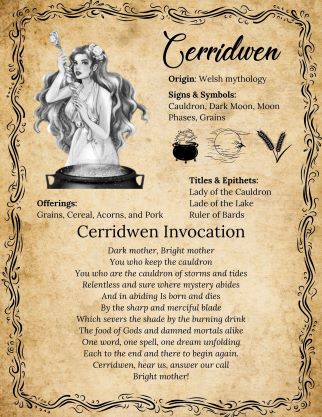
Associations: Magic, fertility, wisdom, poetry, creativity, herbalism, and the harvest.
Role: Cerridwen is the Keeper of the Cauldron, the mother of transformation and change. She brings inspiration, wisdom and the gifts of prophecy to those that work with her. She is seen in Welsh legend as being a crone Goddess, creating a triad with Blodeuwedd and Arianrhod.
Colors: Green.
Animals: Crow, hen, white sow, pigs, hare.
Genealogy: Wife of Tegid Voel. Mother of Morfran, Creirwy and Afagddu.
Cerridwen Offerings
Offerings to Cerridwen (Goddess of poetry and creativity) may include your own original poems, prayers, and songs. Set up an altar for the Goddess using her symbols and correspondences. You can prepare a meal of pork and wheat as an offering to Cerridwen. Alternatively, you may wish to forego pork and wheat for a period of time to show reverence to her sacred symbols.
Approach Her with respect and transparency, as any honest seeker would do with any deity. The best way to connect with Cerridwen is through her mythology. You are encouraged to read her myth and invocation, write poetry or prose for Her, or make an offering on an altar with white and green candles dedicated to her.
Goddess Cerridwen Incense
Incense making is a meditative and enjoyable way to exercise your creativity! Make this incense for working with Cerridwen, keeper of the cauldron of knowledge, inspiration and rebirth.
To honor Cerridwen, burn this incense in your rituals. This incense recipe is included in the DIY Witch’s Apothecary Course.
Offerings to Cerridwen: Grain-based products, wheat, barley, rice, peanuts, acorns, poppy or sunflower seeds, vervain, pork, candles, moonstone.
Cerridwen Invocation
Dark mother, Bright mother
You who keep the cauldron
You who are the cauldron
Of storms and tides
Relentless and sure
Where mystery abides
And in abiding Is born and dies
By the sharp and merciful blade
Which severs the shade
By the burning drink
The food of Gods
And damned mortals alike
One word
One word
One spell
One dream unfolding
Each to the end
And there to begin again
Cerridwen
Hear us
Answer our call
Bright mother
From Masks of the Muse © 2009 Veronica Cummer
Further Reading
- Davies, Sioned (trans.) 2007: The Mabinogion
- Green, Miranda. 1995: Celtic Goddesses: Warriors, Virgins and Mothers
- William Skene. 2015: The Four Books of Ancient Wales

